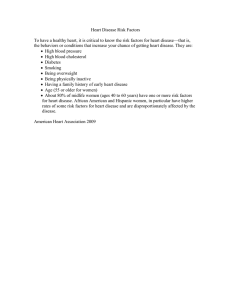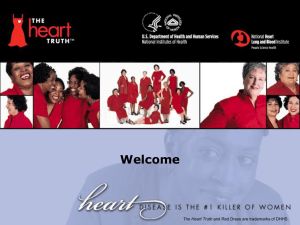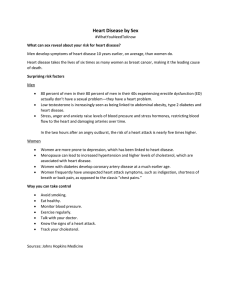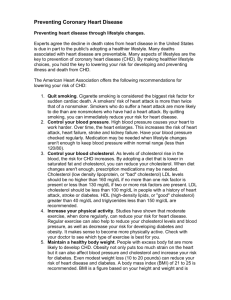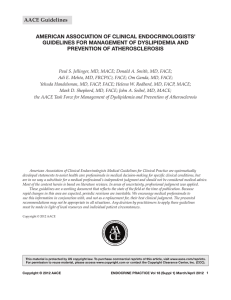Heart Disease: Are you at risk?
advertisement
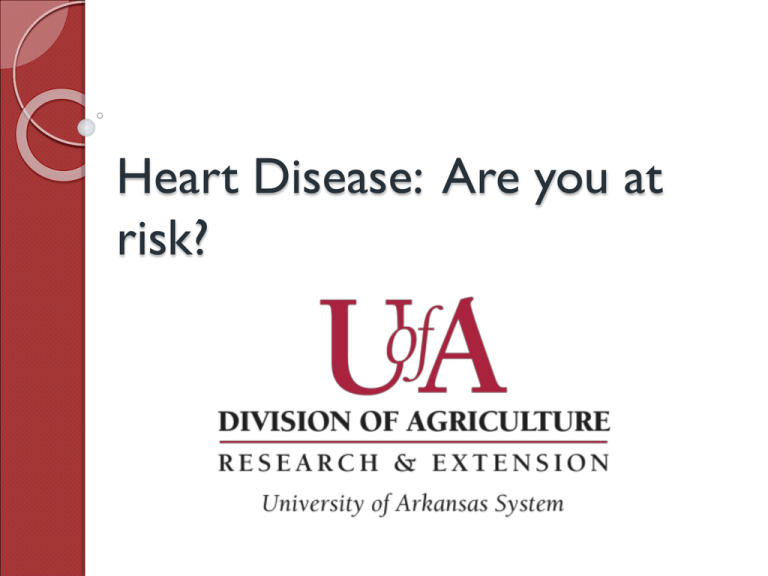
Heart Disease: Are you at risk? Today’s Topics: • • • • • • • Why women need to know about heart disease What heart disease is Risk factors Talking to your doctor Taking action to protect your heart health Heart attack warning signs and survival Getting on the road to heart health Heart Disease • Heart disease is the #1 killer of American women • Heart disease kills more women than all forms of cancer combined • Heart disease can permanently damage your heart—and your life • If heart disease is not treated, serious complications can develop Heart Disease • • • • • Most women do not know that heart disease is their own greatest health risk Heart disease is largely preventable Women can take action to protect their hearts Heart disease is a “now” problem “Later” may be too late Heart Disease • There are many forms of heart disease • Coronary artery disease, or coronary heart disease, is most common • Heart disease develops over years and progresses when the heart doesn’t get enough nutrient-rich blood Atherosclerosis A disease in which plaque builds up inside your arteries, limiting the flow of oxygen-rich blood to your organs Heart Attack Occurs when blood flow to a section of heart muscle becomes blocked, most often, the result of coronary artery disease Good News • Heart disease can be prevented or controlled • Prevention includes lifestyle changes and sometimes medication, if prescribed by a doctor Heart Disease is “now” problem • Young women need to take steps to protect their heart health—since heart disease develops gradually and can start at a young age. • Risk rises in women ages 40 to 60 • Estrogen levels drop during menopause • Many women develop one or more risk factors for heart disease during these years • Older women also need to take action against their risks—it is never too late for women to protect their heart health Risk Factors You Can Control • Smoking • High blood pressure • High blood cholesterol and high triglycerides • Overweight/obesity • Physical inactivity • Diabetes and prediabetes • Metabolic syndrome Risk Factors You Cannot Control • Family history of early heart disease • Age (55 and older for women) • History of preeclampsia during pregnancy Other Risk Factors • • • • Sleep apnea Stress or depression Too much alcohol Birth control pills (particularly for women who are over age 35 and smoke) • Anemia • Unhealthy diet Heart Disease Risk Factors • The Multiplier Effect • 1 risk factor doubles your risk • 2 risk factors quadruple your risk • 3 or more risk factors can increase your risk more than tenfold • By doing just 4 things – eating right, being physically active, not smoking, and keeping a healthy weight – you can lower your risk of heart disease by as much as 82 percent Talk to Your Doctor • Women should talk to their health care provider about their risk for heart disease • Prepare a list of questions before a visit • Write down what the health care provider says • Tell the health care provider about lifestyle behaviors, such as smoking or being physically inactive Key Tests for Heart Disease Risk • Blood pressure • Blood cholesterol (total: HDL, LDL, triglycerides) • Fasting plasma glucose (diabetes test) • Body mass index (BMI) and waist circumference • Electrocardiogram • Stress test You Can Lower Heart Disease Risk • Begin today—make changes one step at a time • Don’t smoke—if you are a smoker, ask your health care provider for help in quitting • Be physically active—2 hours and 30 minutes of moderate-intensity aerobic activity each week • Add strength training—2 to 3 times a week You Can Lower Heart Disease Risk • Follow a healthy eating plan • Low in saturated fat, trans fat, and cholesterol and moderate in total fat • Limit salt and sodium • Limit alcoholic beverages to no more than one a day (2 for men) • Choose a variety of whole grains, fruits, and vegetables daily • Choose fish, poultry, and lean cuts of meat • Use nonfat or low-fat milk, cheeses, and yogurt • Maintain a healthy weight You Can Lower Heart Disease Risk • Manage diabetes, high blood pressure, and high blood cholesterol through living a healthy lifestyle • Take medication, if prescribed Surviving a Heart Attack • If you have any heart attack symptoms or think you might be having a heart attack, call 9-1-1 immediately for emergency medical care Heart Attack Symptoms • Chest pain, discomfort, pressure, or squeezing • Upper-body pain or discomfort in one or both arms, the back, shoulders, neck, jaw, or upper part of the stomach • Shortness of breath • Breaking out in a cold sweat • Unusual or unexplained fatigue (tiredness), particularly in women (which may be present for days) • Nausea/vomiting • Light-headedness or sudden dizziness Minutes Matter! • Learn the warning signs • Call 9-1-1 immediately—fast action saves lives • Emergency medical personnel will begin treatment at once • Don’t drive yourself to the hospital • Uncertainty is normal—don’t be embarrassed by a false alarm • Plan ahead by making a heart attack plan with your health care provider Prevention Begins with You • • • • Take one step at a time Replace unhealthy habits with healthier ones Eat for a healthy heart Start walking—try 10 minutes and add time gradually to reach 2 hours and 30 minutes each week How to Keep Going • View changes as a new lifestyle, not quick fixes • Set realistic goals • Buddy up • Don’t worry about slipping up—get back on track • Reward your successes • Be your own advocate— ask questions and seek information It’s up to you to protect your heart health—start today! This presentation was adapted from The Heart Truth for Women: A Speaker’s Guide. The Heart Truth is a national awareness campaign for women about heart disease sponsored by the National Heart, Lung, and Blood Institute (NHLBI), the National Institutes of Health (NIH), U.S. Department of Health and Human Services (HHS) in partnership with the Office on Women’s Health (OWH).
